Format Ongoing Number of issues 167 | Publication date May 1963 - Dec. 1981 Creator(s) Stan LeeJack Kirby | |
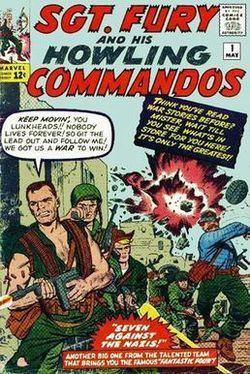 | ||
Inker(s) Dick AyersGeorge RoussosJohn Severin Similar Nick Fury's Howling Commandos, Strange Tales, Tales of Suspense, Tales to Astonish, Journey into Mystery | ||
Tribute to sgt fury and his howling commandos
Sgt. Fury and his Howling Commandos are a fictional World War II unit appearing in American comic books published by Marvel Comics. Created by Stan Lee and Jack Kirby, they first appeared in Sgt. Fury and his Howling Commandos #1 (cover dated May 1963). The main character, Sgt. Nick Fury, later became the leader of Marvel's super-spy agency, S.H.I.E.L.D.
Contents
- Tribute to sgt fury and his howling commandos
- Publication history
- Fictional character biographies
- Members
- Animation
- Live action
- Film
- Collected editions
- References
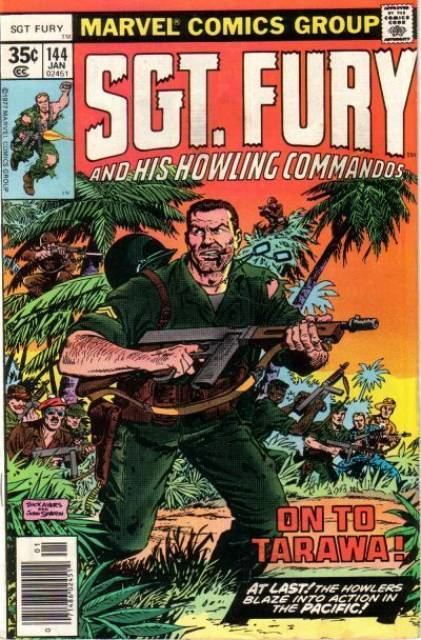
Occasional other members would join for an issue or two before being killed, transferred, or otherwise leaving (such as Fred Jones in issue #81). Also daringly for the time, the series killed Fury's girlfriend, British nurse Pamela Hawley, introduced in issue #4 and killed in a London air raid in #18 (May 1965).
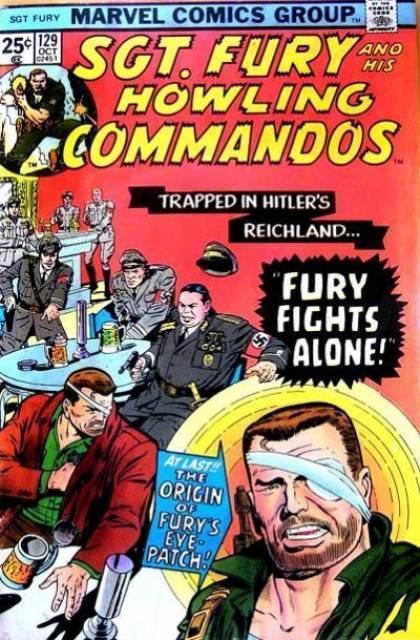
Fury's company commander was Captain Samuel "Happy Sam" Sawyer.
Publication history
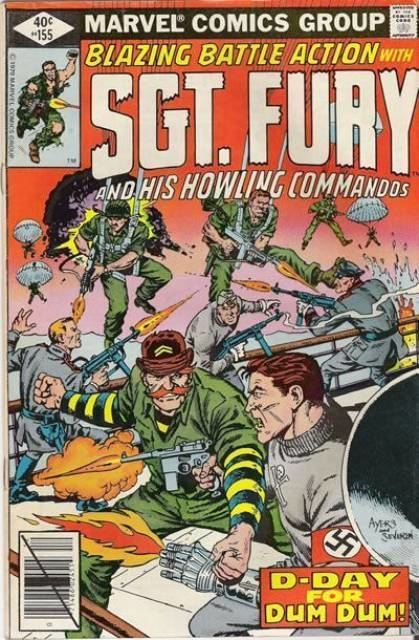
Stan Lee has described the series Sgt. Fury and his Howling Commandos as having come about due to a bet with his publisher, Martin Goodman that the Lee-Kirby style could make a book sell even with the worst title Lee could devise. Lee elaborated on that claim in a 2007 interview, responding to the suggestion that the series title did not necessarily seem bad:
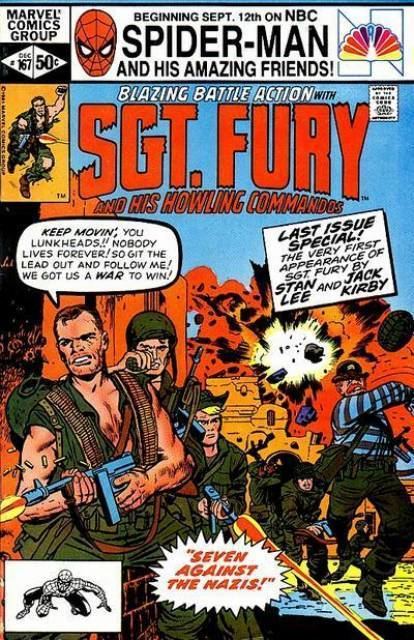
It did at the time. First of all, it was too long for a title — we didn't have any that were six words. And "Howling" was a long word, and "Commandos" was a long word. I got the name "Howling Commandos" because in the Army there was a group called the Screaming Eagles. And I loved the sound of that. So I figured we'd have the Howling Commandos.
Comics-artist contemporary John Severin recalled in an interview conducted in the early 2000s that in the late 1950s, Kirby had approached him to be partners on a syndicated, newspaper comic strip "set in Europe during World War Two; the hero would be a tough, cigar-chomping sergeant with a squad of oddball GIs — sort of an adult Boy Commandos", referring to a 1940s wartime "kid gang" comics series Kirby had co-created for DC Comics.
Sgt. Fury and his Howling Commandos followed an elite special unit, the First Attack Squad, nicknamed the "Howling Commandos", which was stationed in a military base in England to fight missions primarily, but not exclusively, in the European theatre of World War II. Under Captain "Happy Sam" Sawyer, Fury was the cigar-chomping noncom who led the racially and ethnically integrated unit, unusual for the time. Even in the early 1960s, Lee was obliged to send a memo to the color separator at the printing plant to confirm that the character Gabe Jones was African American, after the character had appeared with Caucasian coloring in the first issue.
The series ran 167 issues (May 1963 - Dec. 1981), though with reprints alternating with new stories from issue #80 (Sept. 1970), and only in reprints after issue #120 (July 1974); at this point the formal copyrighted title in the indicia, which had been simply Sgt. Fury, was changed to match the trademarked cover logo, Sgt. Fury and his Howling Commandos. Following seven issues by creators Lee and Kirby (who returned to collaborate on #13 and on the opening and closing pages of #18), penciller Dick Ayers began his long stint on what would be his signature series, penciling 95 issues, including two extra-length annuals. John Severin later joined as inker, forming a long-running, award-winning team; he would, additionally, both pencil and ink issues #44-46. The series' only other pencilers came on one issue each by Tom Sutton (which Ayers said was "done that time I asked for a furlough and reassignment") and Herb Trimpe ("They shuffled Trimpe and me around, [him] to Fury and [me] and Severin to [The Incredible] Hulk" Ayers recalled.)
Roy Thomas followed Lee as writer, himself followed by Gary Friedrich, for whom this also became a signature series. Ayers said in 1977, "Stan Lee left Fury first to Roy Thomas because the superheroes were gaining in popularity at that time it was best he concentrate on them", referring to the young Marvel's then growing line of superhero comics, such as Fantastic Four and The Amazing Spider-Man. "I must admit I resented somewhat those superheroes taking Stan away from Fury!
Friedrich began as a co-scripter of issues #42-44 (May–July 1967). The Friedrich-Ayers-Severin team began in earnest, however, with #45 (Aug. 1967), the first of what would be several of the series' "The" stories: "The War Lover", a shaded exploration of a trigger-happy soldier and the line drawn, even in war, between killing and murder. Daring for the time, when majority public sentiment still supported the undeclared Vietnam War, the story balanced present-day issues while demonstrating that even in what is referred to as "a just war", a larger morality prevails. As one writer in the 1970s observed,
...Sgt. Fury #45 took a firm moralistic stance for the rest of the series by premiering what would become one of the most acclaimed series of stories in comics: the Gary Friedich "The" series, beginning with "The War Lover". ... Future stories in that fashion — all but one written by Friedrich — would center on what war could do to "The Assassin" (#51), the tragedy of a man turned hired liquidator, his family held hostage by Hitler's Gestapo; "The Informer" (#57), an observation on loyalty and trust, staged in a German P.O.W. camp; "The Peacemonger" (#64) [about a World War II conscientious objector]; "The Deserter" (#75), an allusion to the real-life execution of Private Eddie Slovik; "The All-American" (#81), Al Kurzrok's tale of a man [caught] between the twin microcosms of sport and war; and ultimately, "The Reporter" (#110), an account of a journalist faced with the [question of] when might a human life be forfeit? Many feel, also, that #46's tale, "They Also Serve", should be included ... for that story might as easily have been called "The Medic"....
At his best, Ayers' art in Sgt. Fury showed "a clear, forthright storyteller, excellent in medium close shots with a subtly out-of-focus background. He blended large panels with thin or small ones for movement, and often provided vast, cinemascopic panoramas for his writers to work with.... [E]ven in a scene that would ordinarily be static you could feel his characters breathing." Inker Severin "took the art even further, laying dark, scratchy inks" that gave grit to Ayers' pencils. Ayers himself "liked the results of John Severin's work on Sgt. Fury immensely", he said in 1977. "He added details beyond what I'd put in. He always seemed to go one step beyond."
Friedrich continued through #83 (Jan. 1971), with the late part of this run having reprint issues alternating with new stories. He returned for the even-numbered issues from #94-114 (Jan. 1972 - Nov. 1973).
Sgt. Fury ran concurrently with two other, short-lived Marvel World War II series, Capt. Savage and his Leatherneck Raiders (later titled Captain Savage and his Battlefield Raiders), which lasted 19 issues from 1968–1970; and Combat Kelly, which lasted nine issues from 1972-1973. The Howlers guest starred in #6 and #11 of the former series, and #4 of the latter.
Lee explained the series's transition to reprints: "... so much fan mail came in from readers who wanted more of Sgt. Fury, but we didn't have time, I didn't have the men to draw it, I didn't have the time to write it, and we were busy with other things, so we just started re-printing the books, and strangely enough, the reprint versions of Sgt. Fury sold as well as the original ones had!" The final issue, #167 (Dec. 1981) reprinted the first issue.
Seven annual publications appeared, the first titled Sgt. Fury and his Howling Commandos Special King Size Annual #1 (1965), and the remainder titled Sgt. Fury and his Howling Commandos King-Size Special #2-7 (1966 - Nov. 1971), with hyphen and sans "Annual". The final three contain reprints only, save for a 10-page framing sequence in #6. In annuals #1 and #3, the Howlers reunited for a special mission each in the Korean War and the Vietnam War, respectively; annual #2 found them storming the beaches at Normandy on D-Day in 1944, and annual #4 was a flashback to the Battle of the Bulge.
One latter-day story was published in Sgt. Fury and his Howling Commandos #1 (July 2009), as the cover logo read; its copyright indicia read Sgt. Fury & His Howling Commandos One-Shot #1. The 32-page story, "Shotgun Opera", was by writer Jesse Alexander and artist John Paul Leon.
Fictional character biographies
Nicholas Joseph Fury was the eldest of three children born to Jack Fury. His father was a United States citizen who enlisted in the United Kingdom's Royal Flying Corps during World War I. Jack had enlisted in 1916, and later stationed in France. Given the rank of lieutenant, he reportedly shot down Baron Manfred von Richthofen early in the Red Baron's flying career, and was a highly decorated combat aviator by the end of the war in 1918.
Discharged after the War, Jack returned home, married an unnamed woman, and became father of three children. Jack's first wife died when Nick was a very young child; Jack married again, but shortly afterward the second Mrs. Fury also died, while Nick was in childhood. Nick, probably born in the late 1910s or early 1920s, was followed by Jacob "Jake" Fury (later the supervillain Scorpio, who co-founded the Zodiac cartel), and their sister, Dawn.
All three children grew up in the neighborhood known as Hell's Kitchen in Manhattan, New York City, New York. Nick was an amateur boxer. In issue #34 (Sept. 1966) we learned that with his friend Red Hargrove, he eventually left the neighborhood to pursue his dreams of adventure, eventually settling on a daring wing-walking aviation act. Their death-defying stunts caught the attention of Lieutenant Samuel "Happy Sam" Sawyer when Fury and Hargrove were training British Commandos in low-level parachuting. Sawyer was serving with the British Commandos in 1940 and underwent training by Fury. Sawyer enlisted them for a special mission in the Netherlands. Nick and Red later joined the U.S. Army, with Fury undergoing basic training under a Sergeant Bass at Fort Dix in New Jersey. Both Fury and Red were stationed at Schofield Barracks, Oahu, Hawaii when the Imperial Japanese Navy attacked the base on December 7, 1941, and Red was among the many killed in the attack on Pearl Harbor.
Sawyer, now a captain, recruited select U.S. Army Rangers to his "Able" Company. Sawyer assigned Fury the command of the First Attack Squad, nicknamed the "Howling Commandos". They and the Second Attack Squad (the "Maulers", led by Sgt. "Bull" McGiveney, with Cpl. "Ricketts" Johnson), and, later, Jim Morita's Nisei squad were stationed in a military base in England to fight specialized missions, primarily, but not exclusively, in the European theatre of World War II, eventually going as far afield as the Pacific theatre, Africa, and, once each, in the Middle East and on the Russian front. Fury fell in love with an English nurse, Pamela Hawley, who died in a bombing raid of London before he could propose to her.
The Howling Commandos' earliest (but not first-published) assignment occurred in the autumn of 1942. They were to recover British rocket scientist Dr. MacMillan from a German military base in occupied Norway. Their success brought the attention of British Prime Minister Winston Churchill, who incorporated the unit into the British Army, and given the title of "Commandos".
The Howlers fought against the likes of German General Erwin Rommel and inter-squad bigotry, often in the same story. Antagonists included Baron Strucker, Captain America's nemeses Baron Zemo and the Red Skull (Adolf Hitler's protégé), and other Axis villains. The Howlers encountered Office of Strategic Services agent Reed Richards (later Mister Fantastic of the Fantastic Four) in issue #3 (Sept. 1963), and fought alongside Captain America and Bucky in #13 (Dec. 1964).
They reunited for missions in the Korean War, where Fury received a field promotion to lieutenant, and the Vietnam War, each in a summer-annual special, as well as at a present-day, fictional reunion gala in issue #100 (July 1972).
Members
In addition to Fury, the elite special unit of US Army Rangers nicknamed the Howling Commandos consisted of
